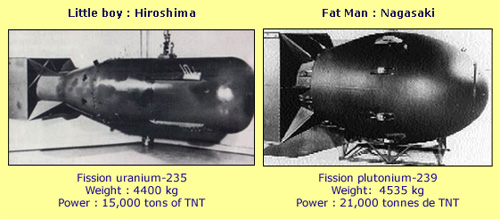In 1938, two German chemists named Otto Hahn and Fritz Strassmann discovered nuclear fission, which is the phenomenon that occurs when two nuclei of an atom are split. This breakthrough discovery was the initial step into using nuclear fission in creating atomic bombs. After this discovery, American, British, and Canadian scientists started to develop nuclear weapons, specifically nuclear bombs. In 1943, Britain and Canada signed the Quebec Agreement, which combined the two countries' research. With the United States, the three countries created the Manhattan Project, which created the first nuclear weapons in history. They worked on these weapons in New Mexico, where they would also conduct tests on the bombs. The final product of these experiments were the two bombs used against Japan, Fat Man and Little Boy. Before they dropped the bombs on Japan, the Allied Powers issued the Potsdam Declaration, which gave Japan an ultimatum of attack if they weren’t to surrender. The first attack was for Hiroshima, a prominent Japanese military and industrial city. Dropped on the city was Little Boy, which only had 1.7% of its material going into fission. 30% of the population of Hiroshima were killed by the blast of the bomb. Around 69% of Hiroshima’s buildings were destroyed. Fat Man, the other bomb, was dropped on Nagasaki, one of Japan’s main seaports. Around 20,000 to 75,000 are said to have died from the immediate explosion, and 100,000 people were killed or injured. After these bombs were dropped, Japan officially surrendered from WWII, but the impact of the bombs stretched greater lengths than just for the war. It created the fear of a weapon so deadly that it could wipe out all of humanity. Because of this, treaties and deals have been signed outlawing the use of nuclear weaponry in war.

Sources:
It's really interesting how a scientific discovery of the way in which principles in chemistry cause the nuclear fission that creates atomic bombs like "Little Boy" and "Fat man". Upon further research, I found that the reasoning behind their odd names was to be code names so that no one suspected what they were planning. "Fat Man" refers to the design of the bomb, as it was wide and had a round shape, while "Little Boy" came from the bomb's narrow shape. "Fat Man" was far more powerful than "Little Boy," which was the first atomic bomb to ever be used in warfare.
ReplyDeletehttps://www.hanford.gov/page.cfm/Famous/Truman
https://thebulletin.org/2015/08/the-harrowing-story-of-the-nagasaki-bombing-mission/
Silent Footage Video depicting preparation and take-off of "Little Boy" and "Fat Man" atomic bombs: https://youtu.be/pXD_fzrcE20
I found it intriguing how you mentioned that only around 1.7% of the material in "Little Boy" succeeded in entering fission, and yet 30% of Hiroshima's population was killed as a result. After some further research, I learned that 99% of the uranium within "Little Boy" was blown apart in the air, so it was very inefficient in regards to its capable destruction, even though it was still unbelievably devastating. Little Boy was a 15 kiloton bomb, with 1.7% of the uranium entering fission. Provided that all of the uranium in the bomb were to go off, it would have been around ~735 kilotons or over 40 times as powerful. It is crazy to think that even with such a low yield detonating, the sheer amount of destruction was still appalling to many, as it took the lives of between 39 and 80 thousand people, with many more receiving dangerous amounts of radiation from fallout.
ReplyDeletehttps://gizmodo.com/less-than-2-of-the-uranium-in-the-hiroshima-bomb-actua-1624444762
I found your blog post really interesting because these two atomic bombs are arguably the most influential findings in war because these weapons are so dangerous and deadly. I like how you explained the statistics after the bombs were dropped and how it impacted Japan. As a result of the devastation caused by the atomic bombing of Japan, the US began assisting Japan in its rehabilitation by providing researches and medication to the Japanese people who were infected by radiation poisoning. The US also invested 2.2 billion dollars for the reconstruction effort.
ReplyDeletesource - https://history.state.gov/milestones/1945-1952/japan-reconstruction
Nice blog post! I researched a bit more on the Manhattan Project. I learned that its origin came partly from fears of a German atomic program. In particular, refugee scientists from the Axis powers sent the Einstein-Szilard letter to Roosevelt in 1939. Roosevelt ended up creating a committee to investigate the possibilities of uranium and the German atomic program. In 1941, Roosevelt approved the atomic program, leading to the building of Fat Man and Little Boy
ReplyDeletehttps://www.britannica.com/event/Manhattan-Project
https://www.atomicheritage.org/key-documents/einstein-szilard-letter
Really cool blog post. I love reading about World War 2 technologies! Adding on to your comment, these fears of Germany's nuclear program were largely unfounded as they were never really even close to developing a bomb. Hitler never had the connections needed with top scientists. In addition, Japan's army actually contained widespread anti surrender sentiments with Vice Admiral Takijiro Onishi at the forefront of the ideology. He was prepared to sacrifice millions of more lives for the cause. In fact, many Japanese were willing to sacrifice more losses for the cause of the war. Ultimately, Emperor Hirohito announced Japan's surrender on August 10, 1945.
Deletehttps://www.nytimes.com/1988/11/13/magazine/hitler-and-the-bomb.html
http://www.hiroshima-remembered.com/history/nagasaki/page6.html